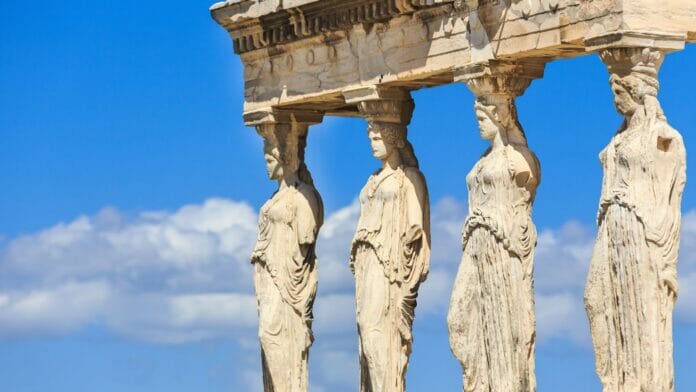King Minos, the ruler of Crete, had taken control of Athens and demanded tribute in the form of seven young Athenian boys and seven young Athenian girls to feed to the Minotaur, a half-man, half-bull monster locked in a labyrinth. When Athens refused to continue the tribute, King Minos’s actions led to the city being besieged by the Cretan army.
The Athenian hero Theseus volunteered to be one of the tributes and went to Crete, intending to kill the Minotaur and put an end to the sacrifices. With the help of King Minos’s daughter, Ariadne, Theseus navigated the labyrinth and emerged victorious against the Minotaur. He then led the Athenian youths and maidens back to Athens with Ariadne.
King Minos, enraged by Theseus’s success, pursued the Athenians back to Athens but was defeated and forced to retreat. This event marked the downfall of King Minos and the rise of Athens as a powerful city-state in ancient Greece.
Background Information on King Minos
In the ancient Greek tragedy, “Cruel Tribute,” King Minos plays a key role in the plot. In this play, Minos is the powerful ruler of the city of Crete who seeks to impose his will and power by besieging the city of Athens.
In order to understand Minos’s actions and motives, it is important to look at his background and the events which lead up to his decision to take a cruel tribute from the people of Athens.
Who is King Minos?
King Minos was a legendary figure in Greek mythology, son of Zeus and Europa, who ruled over the island of Crete. He is best known for his alliance with the Greek god Poseidon, who provided him with a magnificent white bull as a sign of approval for his reign.
However, King Minos’ downfall was his wife’s love for this bull, which led to the birth of the monstrous Minotaur. The Minotaur had to be fed human sacrifices to keep him appeased, which enraged the Athenians after they were forced to send their youths to Crete every nine years to be sacrificed.
King Minos’ actions ultimately led to the city of Athens being besieged by the Athenian hero Theseus, who vowed to end the sacrifices and kill the Minotaur. Theseus succeeded in his quest and returned to Athens victorious, putting an end to the reign of King Minos.
| Pro tip: | Delve deeper into Greek mythology and discover the many fascinating stories of the gods and heroes of ancient Greece. |

In The Plot of “Cruel Tribute,” Which Events are a Result of King Minos’s Actions? Select 3 Options
The “Cruel Tribute” plot is a story of greed, punishment, and violence that centres around King Minos and the city of Athens. As the story goes, King Minos of Crete prayed to the god Poseidon for a magnificent bull to sacrifice as a sign of his power. Poseidon granted his request and Minos was given a prized bull that he couldn’t bring himself to kill. Instead, he kept it and sacrificed another bull in its place. Poseidon was angered by this disloyal act and caused the bull to become wild and uncontrollable, thus eventually leading to the creation of the Minotaur.
To punish Athens for the actions of a hero, King Minos demanded that they send seven young men and women each year to be sacrificed to the Minotaur. This went on for years until the hero Theseus was eventually able to slay the Minotaur and end the cruel tribute.
What were King Minos’s actions in the plot?
King Minos was a legendary figure in Greek mythology, known for his actions in the plot of the story of Athens and Crete. According to the myth, King Minos was the king of Crete, and the son of Zeus and Europa. He was known for his wisdom and strength, and for his ability to keep his kingdom safe from invaders.
However, his actions ultimately led to the city of Athens being besieged by the Cretans. This was because King Minos asked the Athenians to send seven young men and seven young women to be sacrificed to the Minotaur, a creature with the head of a bull and the body of a man, as punishment for the death of his son. When Athens refused to comply with his demands, King Minos declared war on the city and laid siege to it, leading to a long and difficult battle.
The Consequences of King Minos’s Actions
In the plot of “Cruel Tribute,” King Minos has a significant impact on the events that take place in the story. His actions result in a range of outcomes, from the way the Athenians are treated to the sieging of the Athenian city. In this article, we will explore 3 of the most consequential results of King Minos’s actions.
The anger of the God Poseidon
The wrath of God of the sea, Poseidon, led to dire consequences after King Minos of Crete failed to fulfil his promise to the divine entity. The king’s actions resulted in the city of Athens being besieged by the terrifying Minotaur.
According to the myth, King Minos promised to sacrifice the prized white bull gifted by Poseidon. However, he went back on his word and kept the bull instead. As a result, the God of the Sea cursed Minos’ queen to fall in love with the bull, and she gave birth to the infamous monster, the Minotaur.
In an attempt to contain the monster, King Minos constructed a labyrinth from which no one could escape. However, he demanded seven young men and seven maidens from Athens to be sacrificed to the Minotaur every nine years. When the Athenians stopped sending offerings, King Minos sent his army to attack Athens.
The anger of the God Poseidon serves as a warning to keep our promises or face dire consequences.
Pro tip: Honesty is the best policy. Keep your promises and avoid risking the wrath of the gods.
The curse of the oracle
In Greek mythology, King Minos’s actions resulted in a curse by the Oracle, which led to the city of Athens being besieged.
King Minos of Crete was granted a favour by the god of the sea, Poseidon, who gifted the king a magnificent white bull. However, King Minos broke his promise to sacrifice the bull to the gods, and as punishment, the god of love, Aphrodite, made King Minos’s wife fall in love with the bull, resulting in the birth of the Minotaur. The Oracle’s curse was that King Minos’s son would be killed by the Minotaur, and the king would bring destruction to his kingdom.
King Minos eventually went to war with Athens and demanded that they pay tribute by sending seven boys and seven girls to be sacrificed to the Minotaur. Theseus, the Athenian prince, offered himself as a tribute and killed the Minotaur, but not before King Minos’s actions caused the siege of Athens.
This myth teaches that our actions have consequences, and breaking promises can lead to dire outcomes.
The debt of Athens
The debt of Athens was a direct result of King Minos’s actions, which led to the city being besieged by the Cretan king. According to Greek mythology, King Minos of Crete demanded that Athens send seven youths and seven maidens to be sacrificed to the minotaur, a creature which he kept imprisoned in a labyrinth. These sacrifices continued for several years until the Athenian hero, Theseus, volunteered to be one of the youths sent to Crete. With the help of the king’s daughter, Ariadne, Theseus managed to slay the minotaur and escape the labyrinth. As a result, King Minos attacked Athens, demanding tribute and besieging the city until it could pay its debts.
The actions of King Minos had severe consequences for Athens, leading to a long period of hardship and instability. However, the Athenians eventually overcome these challenges, becoming one of the most powerful and prosperous city-states in ancient Greece.

The Besiegement of Athens
In the plot of the myth of “Cruel Tribute”, King Minos’s actions are a key contributing factor to various events. As a result of Minos’s actions, the city of Athens is besieged by the mythic monster, the Minotaur. Additionally, Minos’s actions are responsible for the construction of the Labyrinth and the sacrificial offering of the Seven Sons and Seven Daughters of Athens to the beast.
The Minotaur and the Labyrinth
In Greek mythology, the Minotaur was a creature with the head of a bull and the body of a man, born to Queen Pasiphae of Crete after she mated with a bull sent by the god Poseidon. To contain the Minotaur, King Minos of Crete commissioned a labyrinth to be built by the inventor Daedalus. The labyrinth was so intricate that no one who entered could ever find their way out again, and the Minotaur was trapped within.
The story of the Minotaur and the labyrinth comes to an important climax during the Besiegement of Athens. As punishment for the death of his son, King Minos demanded seven Athenian boys and seven Athenian girls be sent to Crete as sacrifices to the Minotaur. Theseus, the son of the King of Athens, volunteered himself as a tribute to end this cycle of suffering. With the help of Minos’s daughter, Ariadne, Theseus navigated the labyrinth and killed the Minotaur, freeing Athens from the curse of the sacrifices.
The sacrifices sent to Crete
In Greek mythology, the sacrifices sent to Crete were a result of the actions of King Minos after conquering Athens. The myth goes that Minos demanded Athens to pay tribute of seven young men and seven women every nine years to be sacrificed to the Minotaur – a half-human and half-bull creature that was kept in a labyrinth on the island of Crete.
These sacrifices were carried out until the hero Theseus, one of the victims, killed the Minotaur with the help of Ariadne, the daughter of King Minos. However, later versions of the myth suggest that Theseus’ slaying of the Minotaur led to King Minos’ rage and a subsequent siege of Athens by Cretan forces.
This myth has inspired many artistic and literary works throughout the centuries and has become a symbol of bravery, sacrifice, and resistance against tyranny.
The heroics of Theseus
The heroics of Theseus demonstrate his bravery and cunning as he navigated through trials and tribulations, including the Besiegement of Athens caused by King Minos’s actions.
King Minos, the ruler of Crete, laid siege on Athens after his son was killed during his visit to the city. In order to end the siege, Theseus volunteered to leave Athens and participate in the horrific rite of passage known as the Labyrinth. The Labyrinth was a complicated maze designed by Daedalus to house the monstrous Minotaur, half-man, and half-bull. Theseus, with his exceptional strength, stamina, and intelligence, found and killed the Minotaur and found his way out of the maze by using a ball of thread. Upon returning to Athens, he changed history by becoming the city’s rightful king and bringing about justice.
Theseus’s story inspires us to face our fears and overcome adversity with courage and intelligence.
The Outcome of the Besiegement
In the plot of “Cruel Tribute,” King Minos’s actions result in the city of Athens being besieged. This event ultimately leads to the death of many citizens and the enslavement of many others. It also leads to a period of famine and disruption in everyday life.
In this article, we will explore the outcome of the siege and analyse how King Minos’s actions caused these events.
The defeat of King Minos’s army
The defeat of King Minos’s army at the gates of Athens was a turning point in his campaign against the city-state. Despite his best efforts, the city managed to hold out against his siege, thanks to the intelligence and resourcefulness of its leaders and citizens.
King Minos’s army was sure of victory, possessing superior numbers and weaponry compared to the Athenians. However, the Athenians devised a plan to overcome their adversaries, relying on their knowledge of the local terrain, and their ability to launch surprise attacks. The Athens also managed to block the sea routes and cut off supplies to the besieging army, causing their morale to weaken.
King Minos, in response, tried to break through Athens’s defences, but his repeated efforts failed to establish the breach he needed to take over the city.
Finally, after a long siege, the exhausted and demoralised King Minos had no other choice but to raise the siege and retreat his army.
The defeat of King Minos’s army demonstrated the importance of strategy, planning, and resourcefulness in warfare.
The liberation of Athens
King Minos’s actions resulted in the city of Athens being besieged, but thanks to the liberation of Athens, the city was able to rise again.
The siege of Athens occurred when King Minos demanded that Athenians send him 14 human sacrifices each year. The Athenians managed to delay sending the sacrifices for some time, but eventually, they could no longer avoid their obligation. This led to King Minos invading Athens and besieging the city until they complied.
The liberation of Athens occurred when Theseus, the son of an Athenian king, volunteered to be one of the sacrifices sent to King Minos. Once he arrived in Crete, Theseus was able to defeat the Minotaur with the help of King Minos’s daughter, Ariadne. Theseus then successfully led his fellow Athenians out of the Labyrinth and back to Athens.
The liberation of Athens marked the end of the city’s ordeal and cemented Theseus’s place as a hero of Athenian mythology.

The end of the cruel tribute practice
The cruel tribute practice came to an end as a result of the besiegement that happened due to King Minos’s actions on Athens. The king demanded a tribute of seven young men and seven maidens from Athens every nine years to feed the Minotaur, a monster he had imprisoned in a labyrinth on the island of Crete.
However, during the third tribute, Theseus, a brave Athenian prince, volunteered to be one of the young men and pledged to kill the Minotaur to end the cruel practice. After slaying the monster, Theseus led the other Athenians out of the labyrinth using a ball of thread to trace his steps back.
Upon returning to Athens, Theseus put an end to the tribute practice, thus putting an end to the suffering of many families who had lost their loved ones to the practice.


